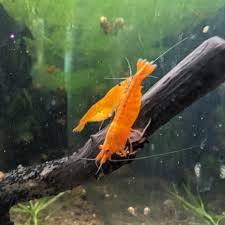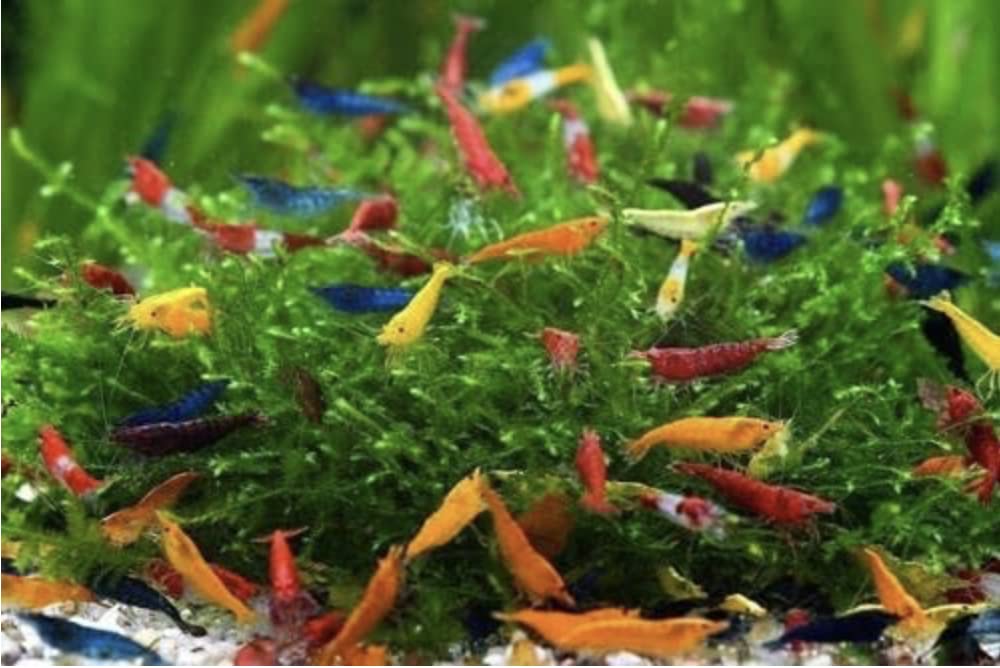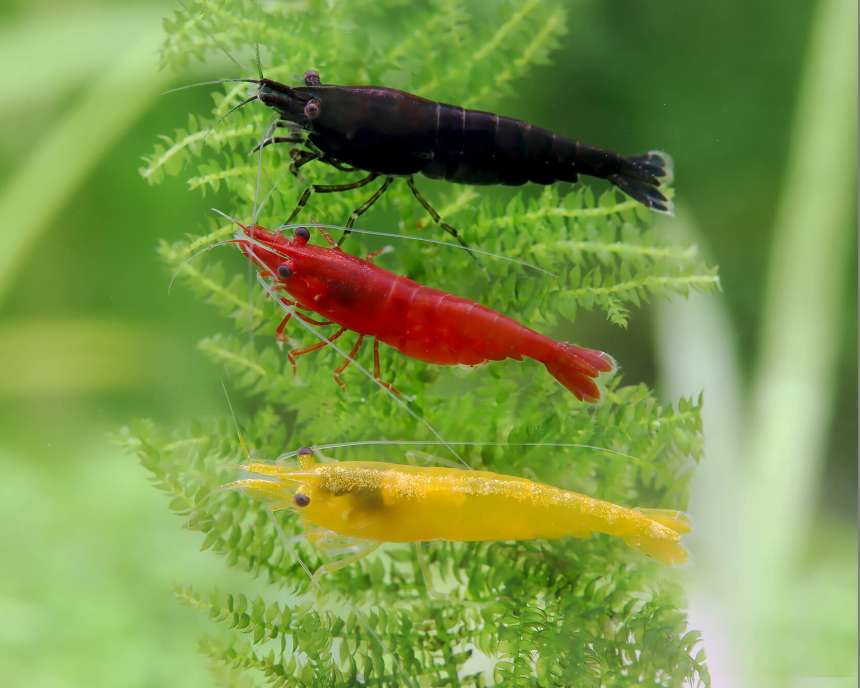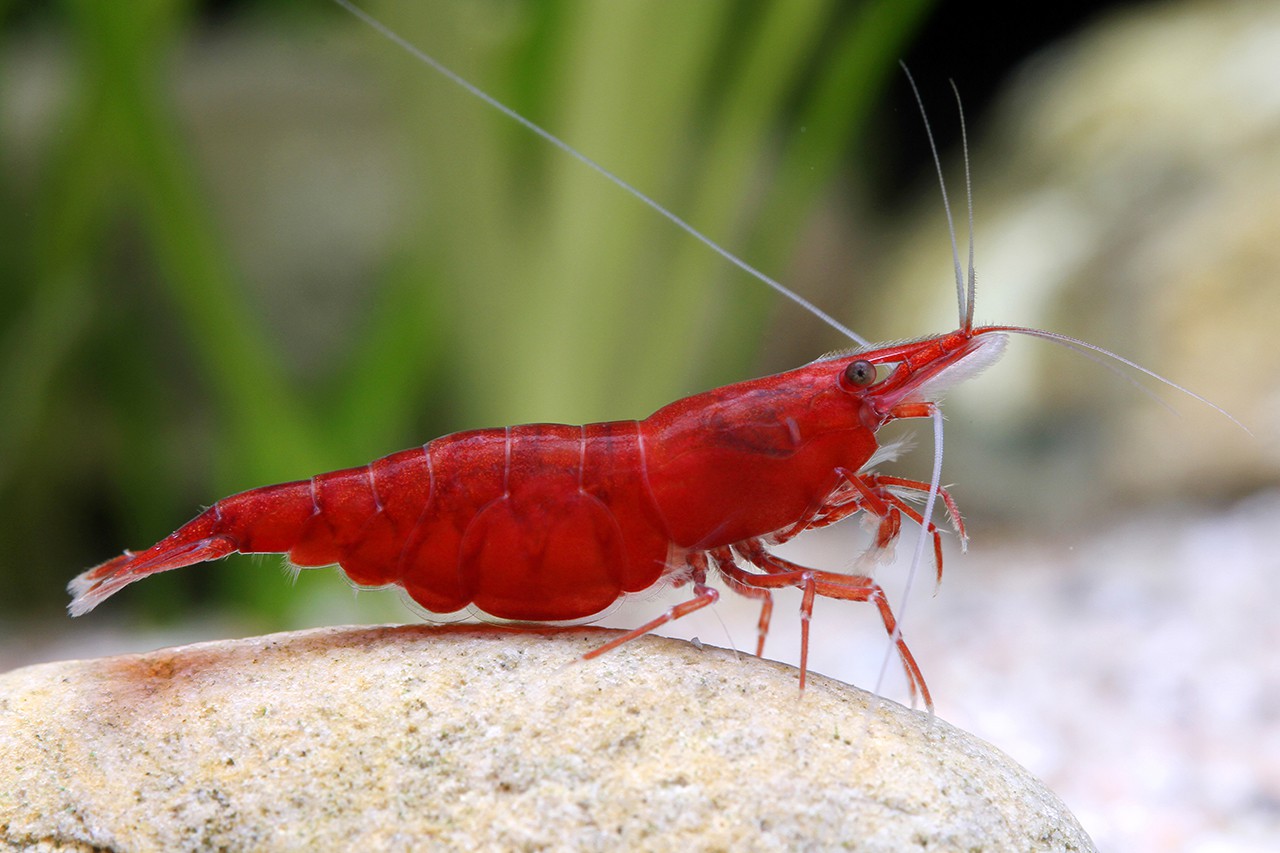Neocaridina Shrimp
Often seen as the jewels of the freshwater aquarium hobby, Neocaridina shrimp are vibrant, active, and surprisingly easy to care for. From the fiery ‘Bloody Mary’ to the dazzling ‘Blue Dream’, these small crustaceans add a dynamic splash of colour to any planted tank. Whether you’re a seasoned aquarist or just starting, our comprehensive guide will walk you through everything you need to know to create a thriving shrimp colony.
Why Keep Neocaridina Shrimp?

Neocaridina davidi, commonly known as Cherry Shrimp and their many colour variants, are arguably the most popular freshwater shrimp in the hobby. Their appeal is easy to understand:
- Vibrant Colours: They have been selectively bred into a stunning array of colours, including red, yellow, blue, green, orange, black, and even white.
- Excellent “Clean-Up Crew”: They are fantastic scavengers, constantly grazing on algae and leftover fish food, helping to keep your aquarium clean.
- Peaceful Nature: They are completely non-aggressive and can be kept with other peaceful tank inhabitants.
- Easy to Breed: In the right conditions, Neocaridina will breed readily, allowing you to watch a fascinating colony grow before your eyes.
Setting Up the Perfect Shrimp Aquarium
Creating the right environment from the start is the single most important factor for success.
Tank Size
While you can keep a small colony in a tank as small as 10 litres, we recommend a minimum of 20-30 litres. A larger tank provides greater stability in water parameters, which is crucial for the health of these sensitive creatures.
Substrate
An inert substrate like sand or fine gravel is ideal. Darker coloured substrates are often preferred as they make the shrimp’s vibrant colours pop and can help them feel more secure. Avoid active substrates that alter water pH unless you are specifically trying to achieve certain parameters.
Filtration: Gentle is Key
Shrimp produce very little waste (bioload), but they are highly sensitive to ammonia and nitrite. A mature, gentle filter is essential.
- Sponge Filters: These are the gold standard for shrimp tanks. They provide excellent biological filtration, a large surface area for biofilm to grow on (a primary food source), and are completely safe for tiny baby shrimp (shrimplets).
- Hanging/Internal Filters: These can also be used, but you must cover the filter intake with a pre-filter sponge to prevent shrimplets from being sucked in.

Plants & Décor: A Shrimp’s Paradise
A heavily planted tank is the perfect shrimp habitat.
- Live Plants: Plants provide cover, security, and surfaces for biofilm to grow. Mosses like Java Moss, Christmas Moss, or Riccia Fluitans are particular favourites. Floating plants can also help to dim the lighting and make shrimp feel safer.
- Hardscape: Driftwood and porous rocks like lava rock are excellent additions. They provide more surface area for grazing and release beneficial tannins into the water.
- Botanicals: Adding dried Indian almond leaves or alder cones can provide a natural food source and release tannins that have mild antibacterial properties.
The All-Important Water Parameters
Neocaridina shrimp are hardy, but they cannot tolerate sudden changes. Consistency is more important than chasing a “perfect” number. Before adding any shrimp, your tank must be fully cycled. This means it has an established colony of beneficial bacteria that can convert toxic ammonia (NH3) and nitrite (NO2−) into less harmful nitrate (NO3−).
Here are the ideal parameters:
- Temperature: 18°C−26°C. A stable room temperature in most UK homes is often sufficient, but a small aquarium heater set to around 22°C will ensure stability.
- pH: 6.5−8.0
- GH (General Hardness): 6−10 dGH. This is crucial. GH provides the calcium and magnesium shrimp need to build their exoskeleton and moult successfully.
- KH (Carbonate Hardness): 2−8 dKH. KH helps to buffer the water and prevent dangerous pH swings.
- Ammonia (NH3): 0 ppm (parts per million)
- Nitrite (NO2−): 0 ppm
- Nitrate (NO3−): Below 20 ppm
Acclimatisation is Critical: When you first get your shrimp, do not simply pour them into the tank. You must drip acclimate them over 1-2 hours to allow them to slowly adjust to your tank’s water parameters.

Feeding Your Neocaridina Shrimp
In a mature, planted aquarium, Neocaridina will find much of their own food by grazing on biofilm and algae. However, you should supplement their diet to ensure they get all the necessary nutrients.
- Primary Diet: Biofilm, algae.
- Supplemental Diet: Feed a high-quality, specialised shrimp food 2-3 times a week.
- Treats: Offer blanched vegetables like spinach, courgette, or kale once a week. Remove any uneaten food after a few hours to prevent fouling the water.
The Golden Rule: Do not overfeed! Overfeeding is one of the most common causes of death in shrimp tanks as it pollutes the water and can lead to bacterial outbreaks. Only feed what your shrimp can finish in an hour or two.
Breeding: Watching Your Colony Grow
One of the most rewarding aspects of keeping Neocaridina is watching them breed. If your shrimp are happy and healthy, it will happen automatically!
- Sexing Shrimp: Females are generally larger, more intensely coloured, and have a rounded underbelly (pleopods) to hold eggs. Mature females may display a yellow or green “saddle” on their back, which is the undeveloped eggs in their ovaries. Males are smaller, less colourful, and have a flatter underbelly.
- “Berried” Females: After moulting, a female will release pheromones to attract a male. Once fertilised, she will carry the eggs under her tail. She is now “berried.”
- Shrimplets: After about 20-30 days, tiny, fully formed shrimplets will hatch. They require no special care and will immediately begin grazing on the same food as the adults. A mature tank with plenty of moss provides the perfect environment for them to hide and find food.
Choosing Tank Mates
The best tank mates for shrimp are… more shrimp! However, if you want to create a community tank, you must choose very carefully.
- The Rule: If a fish’s mouth is big enough to fit a shrimp, it will likely eat it. This is especially true for shrimplets.
- Safe Tank Mates: Otocinclus catfish, small snails (Nerites, Ramshorns).
- Use with Caution: Small, peaceful nano fish like Chili Rasboras or Ember Tetras may be okay in a heavily planted tank, but they might still pick off the odd shrimplet.
- Avoid: Bettas, Angelfish, Gouramis, most Cichlids, Barbs, and Goldfish will see your shrimp as an expensive snack.
Common Health Issues
Most shrimp problems are directly related to water quality or moulting.
- Failed Moult (The “White Ring of Death”): This is often caused by incorrect or fluctuating GH levels. The shrimp is unable to break out of its old exoskeleton and perishes. Maintaining a stable GH is key to prevention.
- Parasites: You may occasionally see green fungal growths (Ellobiopsidae) or small white worms on the shrimp’s head (Scutariella Japonica). These often require specialised treatments. The best prevention is to quarantine all new arrivals (plants and shrimp) before adding them to your main tank.
Conclusion
Caring for Neocaridina shrimp is a wonderfully rewarding experience. By providing a stable, mature environment with the correct water parameters and a well-planted setup, you can enjoy a dazzling, self-sustaining colony for years to come. Their simple needs and vibrant personalities make them the perfect inhabitants for any peaceful freshwater aquarium. Happy shrimping!


